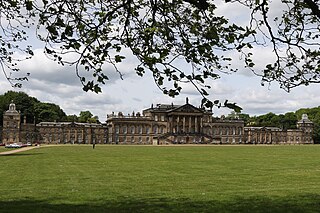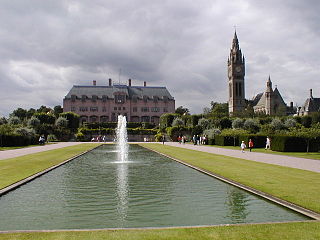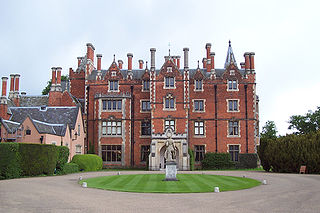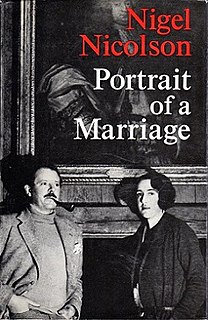
Wentworth Woodhouse is a Grade I listed country house in the village of Wentworth, in the Metropolitan Borough of Rotherham in South Yorkshire, England. It is currently owned by the Wentworth Woodhouse Preservation Trust. The building has more than 300 rooms, although the precise number is unclear, with 250,000 square feet (23,000 m2) of floorspace. It covers an area of more than 2.5 acres (1.0 ha), and is surrounded by a 180-acre (73 ha) park, and an estate of 15,000 acres (6,100 ha).

Anne Spencer Morrow Lindbergh was an American author and aviator. She was the wife of decorated pioneer aviator Charles Lindbergh, with whom she made many exploratory flights.

Victoria Mary Sackville-West, Lady Nicolson, CH, usually known as Vita Sackville-West, was an English author and garden designer.

Knole is a country house and former archbishop's palace owned by the National Trust. It is situated within Knole Park, a 1,000-acre (400-hectare) park located immediately to the south-east of Sevenoaks in west Kent. The house ranks in the top five of England's largest houses, under any measure used, occupying a total of four acres.

Sir Harold George Nicolson was a British politician, diplomat, historian, biographer, diarist, novelist, lecturer, journalist, broadcaster, and gardener. His wife was the writer Vita Sackville-West.

Sissinghurst Castle Garden, at Sissinghurst in the Weald of Kent in England, was created by Vita Sackville-West, poet and writer, and her husband Harold Nicolson, author and diplomat. It is among the most famous gardens in England and is designated Grade I on Historic England's register of historic parks and gardens. It was bought by Sackville-West in 1930, and over the next thirty years, working with, and later succeeded by, a series of notable head gardeners, she and Nicolson transformed a farmstead of "squalor and slovenly disorder" into one of the world's most influential gardens. Following Sackville-West's death in 1962, the estate was donated to the National Trust for Places of Historic Interest or Natural Beauty. It is one of the Trust's most popular properties, with nearly 200,000 visitors in 2017.

Sissinghurst is a small village in the borough of Tunbridge Wells in Kent, England. Originally called Milkhouse Street, Sissinghurst changed its name in the 1850s, possibly to avoid association with the smuggling and cockfighting activities of the Hawkhurst Gang. It is in the civil parish of Cranbrook and Sissinghurst.

Eaton Hall is the country house of the Duke of Westminster. It is 1 mile (2 km) south of the village of Eccleston, in Cheshire, England. The house is surrounded by its own formal gardens, parkland, farmland and woodland. The estate covers about 10,872 acres (4,400 ha).

Charles Raymond Bell Mortimer CBE, who wrote under the name Raymond Mortimer, was a British writer on art and literature, known mostly as a critic and literary editor.

Nigel Nicolson was an English writer, publisher and politician.

Sevenoaks Weald is a village and civil parish in the Sevenoaks District of Kent, England. The parish is located on the Low Weald, immediately south of Sevenoaks town, with the village of Sevenoaks Weald at its centre. It was formed in 1894 from part of the ancient parish of Sevenoaks.

Taplow Court is a Victorian house in the village of Taplow in Buckinghamshire, England. Its origins are an Elizabethan manor house, remodelled in the early 17th century. In the 18th century the court was owned by the Earls of Orkney. In the 1850s, the court was sold to Charles Pascoe Grenfell, whose descendants retained ownership until after the Second World War. The court then served as a corporate headquarters for British Telecommunications Research (BTR) an independent research company set up in 1946. BTR was subsequently acquired by Plessey Electronics. In 1988 it was bought by the Buddhist foundation, Soka Gakkai International and serves as their UK headquarters.

Portrait of a Marriage: Vita Sackville-West and Harold Nicolson is the 1973 biography of writer and gardener Vita Sackville-West compiled by her son Nigel Nicolson from her journals and letters.

Ebury Street is a street in Belgravia, City of Westminster, London. It runs from a Grosvenor Gardens junction south-westwards to Pimlico Road. It was built mostly in the period 1815 to 1860.

Great Fosters is a 16th-century mansion which originally lay within Windsor Great Park and is still adjacent to the town of Egham, Surrey, England. It is a Grade I listed building, close to Heathrow and the M25 London orbital motorway.
Alvilde Lees-Milne was a British gardening and landscape expert.

Cadogan Place is a street in Belgravia, London. It is named after Earl Cadogan and runs parallel to the lower half of Sloane Street. It gives its name to the extensive Cadogan Place Gardens, private communal gardens maintained for Cadogan residents. It is owned by Cadogan Estates.

Buckhurst Park is an English country house and landscaped park in Withyham, East Sussex. It is the seat of William Sackville, 11th Earl De La Warr.

Albert Reginald Powys CBE (1881–1936) was an architect and Secretary of the Society for the Protection of Ancient Buildings for some 25 years in the early 20th century.

Kelvedon Hall is a country house in the village of Kelvedon Hatch, near Brentwood, Essex, England. Originally the site of an important medieval manor, the current house was built in the mid-18th century by a family of Catholic landowners, the Wrights, who had bought the manor in 1538. The last of the Wrights to live at the house died in 1838 and it was then let, before being sold to a school. In 1937 the hall was bought by Henry “Chips” Channon, a wealthy Anglophile socialite. Kelvedon appears repeatedly in Channon’s diaries, an intimate record of his social and political life from the 1920s to the 1950s. The hall remains the private home of the Channon family. It is a Grade I listed building.



















